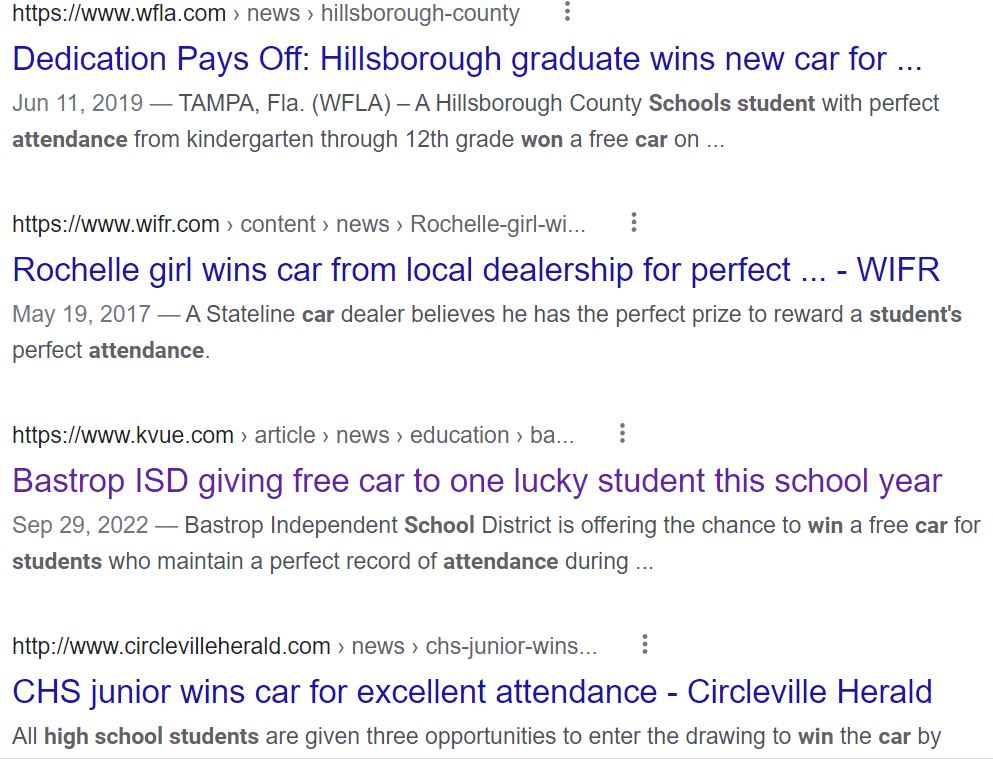Perfect Attendance Can Win High School Students A New Car | What Do You Think? | SDP201
Have you imagined that not missing a day of high school could put you square in the driver’s seat of a new car? What began as a novel truancy pilot roughly twenty years ago is becoming increasingly popular in high schools across America. Why are cash-strapped schools ponying up cars for students with perfect, or near-perfect attendance? What are the outcomes of these incentives? What are the positions of advocates and opponents? In this episode, Doc describes the “cars for attendance” trend speeding through the parking lots of America’s high schools.

DIRECT LINK to MP3 of this Episode: https://tinyurl.com/SDP201-AUDIO
WHAT IS TRUANCY? States have statutory citations for compulsory school attendance and school attendance enforcement. These exist to compel students to attend school on a regular basis. Truancy, or unexcused absence from school, is informally referred to as “skipping school.” A “truant student” is typically absent for several days, or weeks, during the school year. The pattern tends to be pervasive and the lack of regular attendance diminishes the student’s ability to benefit from instruction. Students who are truant are often ineligible to participate in organized sports and generally are not connected with school activities.
TRUANCY REDUCTION: KEEPING STUDENTS IN SCHOOL. In September 2001, the U.S. Department of Justice Office of Juvenile Justice published a 16-page bulletin titled: Truancy Reduction, Keeping Students in School. Truancy had been well-studied by 2001, and although it impacted students of all ages, it was most prevalent in high schools. The report stated, “Truancy has been clearly identified as one of the early warning signs that youth are headed for potential delinquent activity, social isolation, and/or educational failure. Other studies established lack of commitment to school as a risk factor for substance abuse, delinquency, teen pregnancy, and dropping out of school.”
OTHER CONSEQUENCES OF TRUANCY. The DOJ’s 2001 report predicted dire financial impacts of truancy and dropouts, including (1) Less educated workforce, (2) Business loss because of youth who “hang out” and/or shoplift during the day, (3) Higher daytime crime rates, and (4) cost of social services for families of children who are habitually truant.
INCENTIVES FOR STUDENT ATTENDANCE – YOU GET A CAR! In 2022, Bastrop ISD partnered with the local Sames Bastrop Ford dealership to offer one lucky student the chance to win a car in its “Drive Sames 4 Education.” “Kristi Lee, BISD’s district deputy superintendent, said the district has seen a dip in attendance and all students’ grades. The free car acts as an incentive to get students to come back to class.For the 2021-22 school year, BISD had an attendance rate of 90.59% – the lowest rate in the last four years. When the pandemic originally hit, during the 2019-2020 school year, overall attendance was almost three percentage points higher at 93.67% (Comme, P. 2022).” Search engines return thousands of similar stories, from New Caney High School to Honey Grove ISD to San Antonio High School.

ARGUMENTS FOR CARS AND HIGH-VALUE PRIZES. It works. Research has found that financial incentives typically are the most effective in driving teenagers. Oftentimes, parents will reward students with a cash bonus after they produce good grades. But on the contrary, children are more prone to strive for something they can control, like studying or even attendance (Prothero, A. 2017). On the flip side, incentives are much less effective for actual test scores. In other words, incentives work to motivate kids to attend school, but not necessarily to perform well in school. The cost of a car (and some of the prizes are used cars) might be $25,000, or less if donated by a dealership or community philanthropy. That expense is lower than the school funding a truancy officer or cuts to school funding due to lower enrollment.
ARGUMENTS AGAINST CARS AND HIGH VALUE PRIZES. Schools create an artificial external reward system for something that should be internalized as having value. For example, we don’t brush our teeth to receive a chance to win a car from the dental office, although lack of dental hygiene could deteriorate our health and cost thousands of dollars to fix. Another argument is that the fact that high-value prizes increase attendance underscores that traditional school operations don’t motivate students. Maybe it’s a stale curriculum? It’s worth noting The Safety Doc Podcast episode 195 and guest Mike Dahle discussing how Esports is rocketing in popularity in schools – and also contributing to increased attendance. Yet, the majority of schools don’t offer Esports. For car raffles, people claim the optics look bad – of quasi-paying kids to attend school.
SOURCES: Comme, P. (2022). Bastrop ISD giving free car to one lucky student this school year. KVUE.; Prothero, A. (2017). Does Paying Kids to Do Well in School Actually Work? Education Week.
This is episode 200 of The Safety Doc Podcast published on 12-27-2022. This podcast and blog post represent the opinions of David P. Perrodin and his guests to the show. The content here is for informational purposes only. Please consult with your safety professional regarding the unique needs of yourself or your organization.
FOLLOW
- Watch this episode on “The Safety Doc” YouTube channel https://tinyurl.com/SDP201-VIDEO
- Listen to this episode on PodBean MP3 https://tinyurl.com/SDP201-AUDIO
- Apple Podcasts http://tinyurl.com/SafetyDocApplePodcasts
- SAFETY DOC WEBSITE & BLOG safetyphd.com
- Follow David & The Safety Doc Podcast on Twitter @SafetyPhD
- Email Dr. Perrodin [email protected]
Purchase Dr. Perrodin’s books
School of Errors – Rethinking School Safety in America
The Velocity of Information – Human Thinking During Chaotic Times
